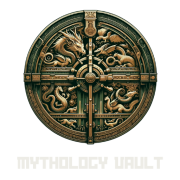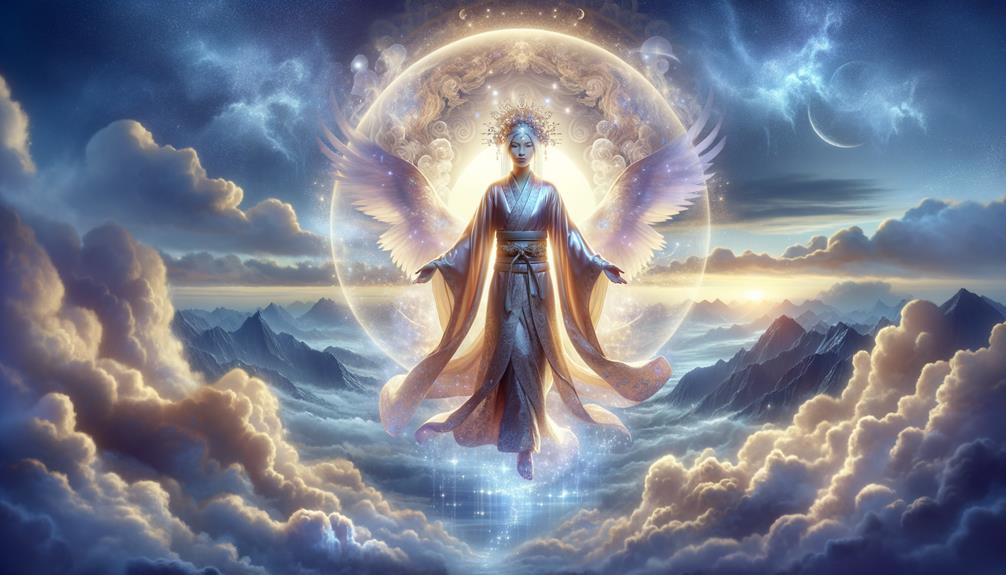In Japanese Shinto folklore, Amenowakahiko embodies the archetype of a celestial emissary, dispatched by Amaterasu herself on a pivotal mission to Earth. Wielding a bow that symbolizes divine authority, his journey mirrors the classic hero's tale, exploring themes of obedience and heavenly duty. However, his demise, struck down by a celestial arrow, serves as a cautionary tale against defying sacred commands. This story isn't merely about his downfall but delves deeper into the balance between mortal ambition and heavenly will, prompting contemplation on the consequences of overstepping divine boundaries.
Mythological Background
Amenowakahiko, known as the 'heavenly messenger,' played a pivotal role in Japanese Shinto mythology as a ruler chosen by the gods to govern the earth. This divine selection underlined his significance and the trust bestowed upon him by celestial deities like Amaterasu, the sun goddess. Gifted a bow symbolizing his authority, Amenowakahiko embarked on a journey marked by immense responsibility and power.
Yet, his tale bears tragedy – his love for Shitateruhime and subsequent death reveal the intricate interplay between human desires and divine will. A fateful encounter with a pheasant and a lethal arrow led to his untimely demise, echoing the themes of fate and divine retribution woven throughout Japanese folklore.
Mission to Earth
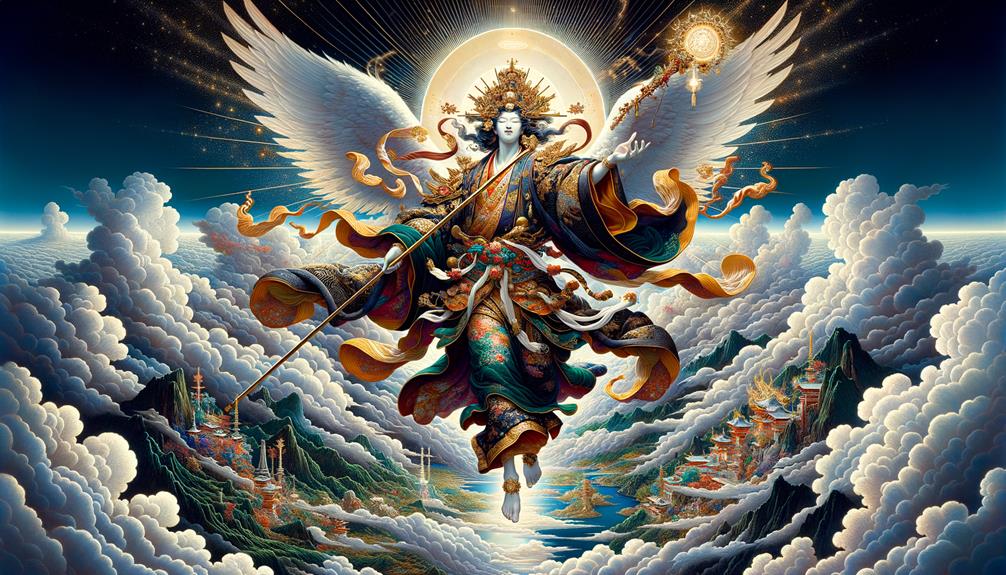
Amenowakahiko's journey to Earth seems guided by profound purpose bestowed upon him by divine forces. Tasked to rule over the earth, he walks a heroic path interacting with celestial beings steering his way. More than mere governance, his mission intertwined destiny and delivering a sacred message to humanity.
Purpose of Visit
In Japanese mythology, Amenowakahiko journeyed to Earth with a clear purpose – to bring stability and elevate living conditions. As an ancestral deity, his role centered around establishing frameworks for society to thrive.
His objectives included:
- Instituting laws and structures for a stable society.
- Guiding agriculture and commerce to improve material wealth.
- Fostering harmony between humans and the divine realm.
Amenowakahiko's story echoes the archetypal hero's quest, where the protagonist undergoes trials to ultimately benefit their community. Ancient texts highlight his exceptional qualities, underscoring why he was chosen for this divine assignment. His journey symbolizes the enduring connection between celestial and mortal realms, reminding us that divine influence shapes our earthly pursuits.
Amenowakahiko's descent to Earth represented more than just a mythological tale; it encapsulated society's need for order, prosperity, and spiritual connection. His mission exemplified the human yearning for balance and guidance from higher powers. Through his story, we glimpse the role of mythology in providing purpose and meaning in the face of life's uncertainties.
Message for Humanity
Amenowakahiko's journey to Earth carried a profound message: find balance between human progress and divine principles. The gods appointed him to govern the world, tasked with fostering prosperity and order. His presence bridged celestial and terrestrial realms, echoing the archetypal hero's quest to harmonize the worldly and sacred.
Amenowakahiko's connection to the sun and agriculture highlighted his role in ensuring the land's fertility and abundance. He aimed to cultivate a thriving society respecting divine guidance. His mission went beyond governing; it united human actions with the cosmic order, allowing the earth to flourish under divine direction.
However, his demise for defying divine will serves as a cautionary tale. The gods' intervention, symbolized by the pheasant and fatal arrow, underscores the peril of overstepping divine boundaries. This story reminds us that while pursuing advancement, we must maintain harmony between human ambition and the divine, ensuring our actions align with the balance set by higher powers.
Demise and Consequences
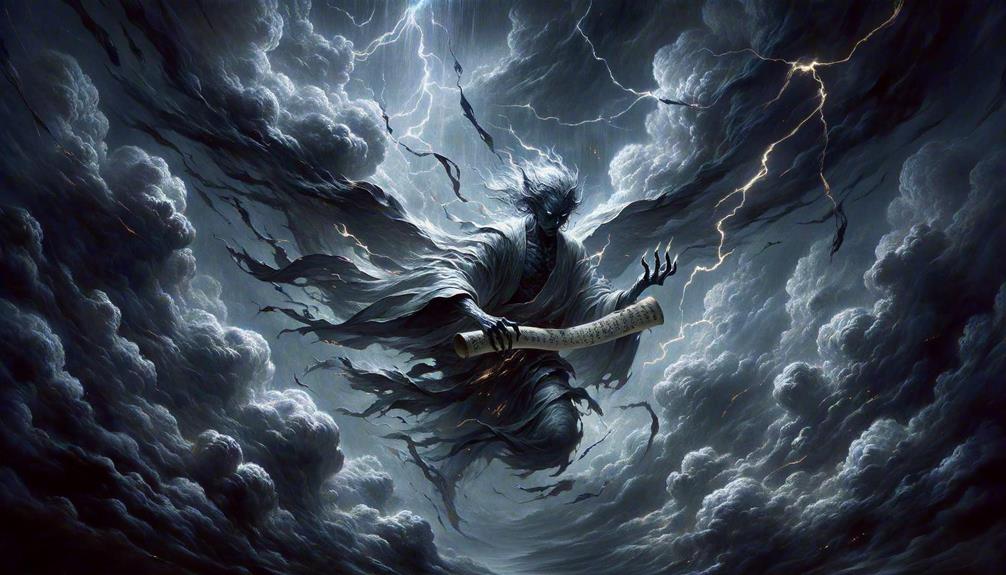
Ame no Wakahiko's fate paints a gripping picture of a violent rebellion's aftermath, shattering his divine mission. Takamimusubi's wrath embodies divine consequences for defying celestial authority – a stark warning about the delicate balance between human ambition and divine will. This tragic end serves as a potent cautionary tale.
Violent Rebellion Outcome
Despite initially rebelling against the divine decree, Ame no Wakahiko's tragic downfall through a celestial arrow strike vividly illustrates the inescapable consequences of defying the gods in Japanese mythology. His fate serves as a grim reminder of the immense power and unforgiving nature of divine retribution.
Ame no Wakahiko, daring to defy the heavenly command, met his demise when a fatal arrow, thrown by the enraged Takamimusubi, pierced through a pheasant before striking him down. This act wasn't mere happenstance but a deliberate divine response to his rebellion, underscoring the celestial dissatisfaction with Ame no Wakahiko's actions.
His tragic end is not just a fable but a profound lesson deeply rooted in Japanese mythological culture. It echoes themes of destiny, divine vengeance, and the repercussions of defiance against the gods' will.
Ame no Wakahiko's narrative, marked by violent rebellion and consequential demise, is a powerful cautionary tale within the hero's journey archetype. It reminds us that in the grand schemes of the divine, mortal defiance leads to an inevitable downfall.
Divine Retribution Impact
The tragic death of Ame no Wakahiko, struck by a divine arrow after a woman's warning, highlights the unrelenting force of divine retribution in Japanese mythology. His demise wasn't an isolated tragedy; it served as a stark reminder of defying celestial commands. When Takami-Masubi recognized the divine arrow, it set in motion a series of events leading to Ame no Wakahiko's downfall.
This tale cautions that even celestial beings aren't immune to the consequences of their actions. Ame no Wakahiko's rebellion against the divine order prompted swift, unforgiving punishment. His death reaffirmed the celestial hierarchy and the inviolability of divine mandates within Japanese mythology.
The impact of his defiance reinforces cultural beliefs surrounding obedience to divine will. Ame no Wakahiko's story significantly contributes to Japanese folklore, embodying themes of fate, divine retribution, and a hero's journey gone awry. His demise stands as a timeless reminder that respecting the divine order is paramount, lest one face the wrath of celestial forces.
Funeral Rites
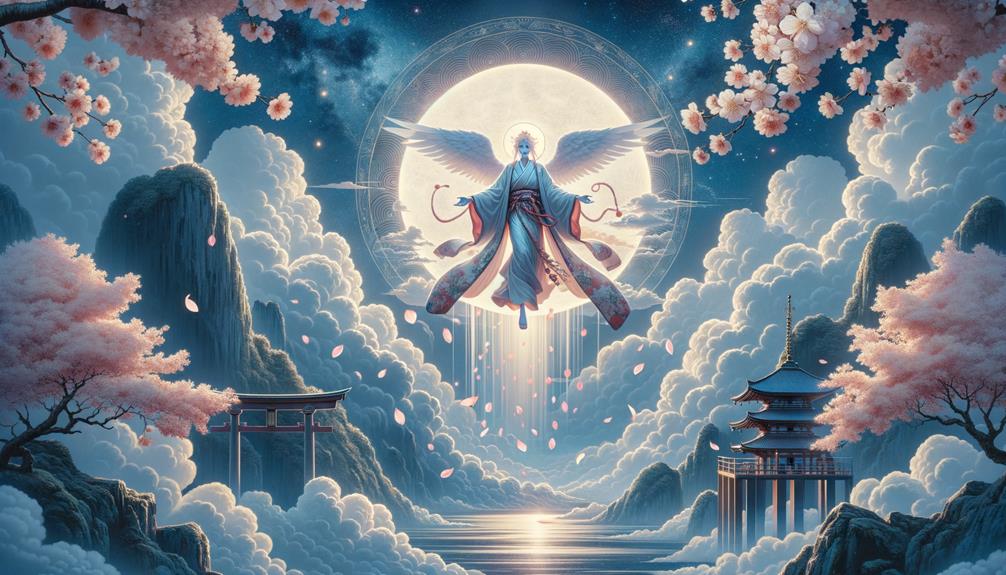
Honoring Amenowakahiko Heavenly Messenger through funeral rituals intertwines purification practices, offerings, and symbolic acts rooted in ancient traditions and regional customs. These rituals transcend mere ceremonies, serving as an archetypal journey echoing mythological narratives and heroic quests. Purification rituals cleanse the material and spiritual realms, ensuring the path to the afterlife remains untainted.
Offerings like food, sake, and heartfelt prayers play a crucial role, symbolizing respect and gratitude towards Amenowakahiko. The rituals often involve special ceremonies and chants performed by priests or shrine attendants, symbolic gestures like lighting incense or pouring sacred water, and regional customs that maintain the essence of reverence and homage.
Each ritual act mirrors the hero's journey, where Amenowakahiko's essence transcends mortality. These rites connect us with the divine, understanding that our offerings and actions are threads woven into an enduring mythological tapestry.
Legacy and Worship
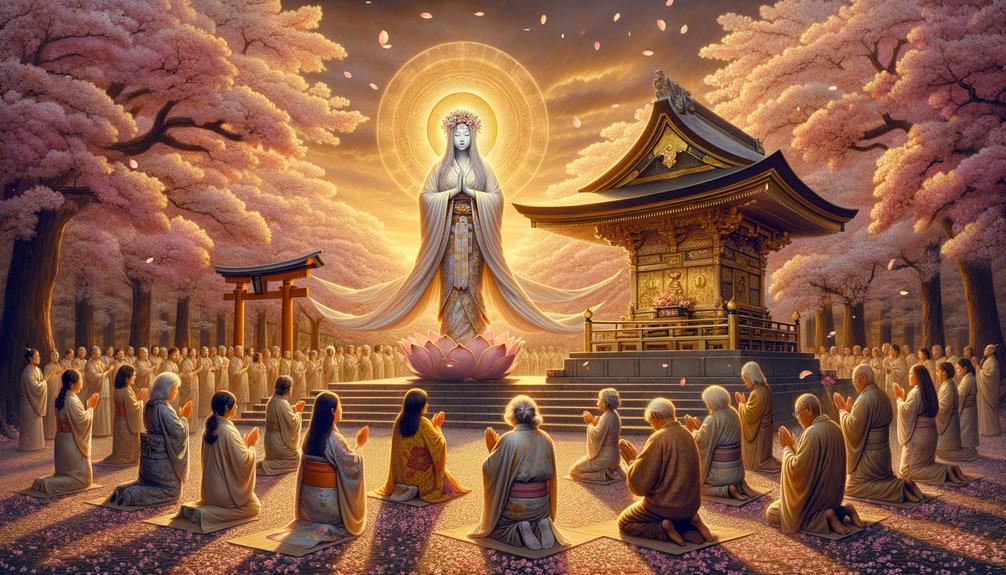
Amenowakahiko's impact on Japanese spirituality has persisted through generations, with shrines like Abiko and Iwakura venerating his spirit to this day. His epic tale, filled with divine purpose and mortal struggles, echoes the archetypal hero's journey culminating in transcendence.
After death, a misunderstanding led people to believe a hut honored Ajisukitakahikone as Amenowakahiko himself. This twist enriched the mythology surrounding his life. As the ancestral deity of the Hozumi and Mononobe clans, Amenowakahiko's influence extends to Japan's cultural identity.
Shrines including Amateru Tamamikoto and Ishikiri Kenjya continue venerating him eight centuries later. Even the renowned Izumo Taisha celebrates his narrative through worship and academic study. Amenowakahiko's enduring presence in folklore highlights humanity's timeless quest to understand our cosmic place.
Related Myths
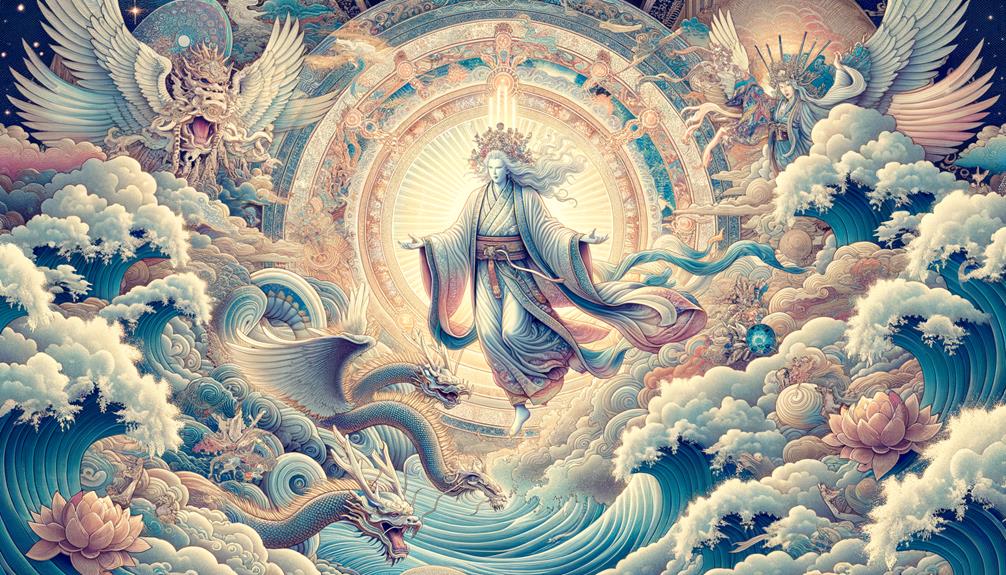
Many Japanese myths featuring Amenowakahiko explore divine intervention's role and challenging celestial authority's consequences. The Nihon Shoki vividly recounts one compelling tale where Amenowakahiko's tragic fate highlights the delicate balance between earth and heaven.
One significant story involves the gods sending a pheasant as a messenger to find Amenowakahiko, setting off a dramatic chain of events:
- Amenowakahiko mistakes the pheasant for an enemy and fatally shoots it with an arrow.
- Takamimusubi, an important deity, recognizes the arrow and angrily throws it back to earth, killing Amenowakahiko.
- The spot where he fell is marked by a tree, symbolizing the connection between divine will and earthly actions.
This myth cautions about fate and defying the gods' dire consequences. It exemplifies the hero's journey archetype, where forces beyond Amenowakahiko's control dictate his rise and fall. These stories impart profound lessons embedded in Japanese folklore, reflecting humanity's timeless struggle to reconcile ambition with a higher order.
Frequently Asked Questions
What Is Umashiashikabihikoji the God Of?
Umashiashikabihikoji plays a nurturing role in myth, governing agriculture, food production, and fertility. This deity oversees bountiful harvests and crop growth, sustaining entire communities as an archetypal provider.
Who Is the God Amenomikanushi?
Amenomikanushi, the primordial deity in Shinto mythology, represents the chaotic origins from which existence emerged. As a formless, genderless entity, it symbolizes the initial spark that ignited the cosmic journey towards order and creation. Visualize a primal force devoid of form, yet bursting with infinite potential, initiating the birth of the universe as we know it.
What Is the Power of Ame No Minakanushi?
Looking into the theory, Ame no Minakanushi's power maintains cosmic equilibrium and unity. As the universe's primordial source, this deity embodies the archetypal concept of interconnectedness, guaranteeing divine harmony and balance.
Who Are the Three Shinto Gods?
Amaterasu, Susanoo, and Tsukuyomi form Japan's mythological triad. Amaterasu symbolizes the sun and leadership; Susanoo personifies chaos and storms; while Tsukuyomi reflects the moon and contemplation. These deities shape the nation's cultural heritage and narrative storytelling.
